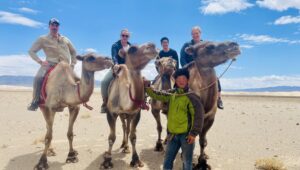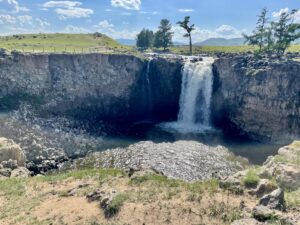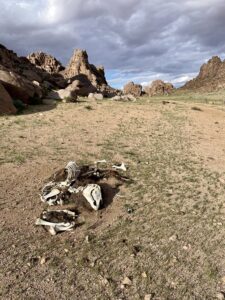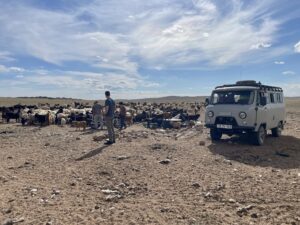“Colin, this is the real deal” whispered Law excitedly, as he photographed a nomadic family in their living environment. I couldn’t stop laughing. Law said it as if he was capturing footage of some rare animal when, really, it was just people living their everyday life. We were somewhere on a lunch stop in the great Mongolian Steppe, isolated from everything but grassy plains, wild horses, and this one family. We were not, however, at some Mongolian zoo, or in the mountains seeing the elegant and elusive snow leopard or endangered Mazaalai “Gobi” bear.

Behind my laughter, I knew what Law really meant: this was a “real deal” travel moment. Moments of raw authenticity like this are what we so deeply crave for when we travel, and my time in Mongolia was full of them.
After 3 weeks in Mongolia, I have concluded that this massive landlocked country is “the real deal” travel destination. 99.7% of Mongolia is practically empty but it is in this emptiness where there is a fullness of authentic adventure, distinctive culture, and riveting history. This is why Mongolia will leave with me an enduring impression, is justifiably placed as Lonely Planet’s #1 Travel Destination in 2024, and is one of my favourite countries I have travelled to.
Here are 22 musings and observations from my 3 weeks in Mongolia, followed by some of my favourite photos. Half my time in Mongolia was spent in the capital city of Ulaanbaatar and the other half was spent in the countryside, including in the Gobi Desert and Orkhon Valley.
22 Mongolian Musings and Observations
1 – Why Mongolia? I am realizing that the uncharted or less charted paths are the ones that have always appealed to me. Many of my past decisions can be pointed to as evidence. Accordingly, I knew I wouldn’t be satisfied if I didn’t visit at least one lesser travelled country in my summer off – a place more off the beaten path that would challenge me as a solo traveller, which offered something “different”. When I saw Mongolia listed as the top destination to visit in Lonely Planet’s “Best in Travel 2024” guide, due to its “wide-open spaces, adventure activities and natural beauty”, and combined with my interest in history’s great leaders like Genghis Khan, I was hooked on the idea of going. Mongolia thus became the centrepiece of my explore Asia post law-school trip.

2 – Mongolia = “Travel Cred”. The pursuit of respect (“cred”) within certain social circles may be a reason why less charted paths appeal to me and others. Because Mongolia is lesser travelled (according to one link, it is the 5th least travelled to Asian country, behind Bhutan, Papua New Guinea, Brunei, and Yemen), it is a place that gives you solid “travel cred”, as does visiting countries like Albania, Pakistan, and Bangladesh. What country gives the most travel cred? Afghanistan or North Korea come to mind. Would going on a guided tour void any travel cred gained?
3 – The Unescapable Presence of Chinggis Khan. I’m a little embarrassed to admit that the only thing I knew about Mongolia before arriving was that it was associated with Genghis Khan, and that he had a lot of children (Oxford’s biochemistry department concluded he had 16 million descendants). If you didn’t know about him before arriving, you will find out his importance to Mongolia immediately. He is everywhere! Enormous statues, museums dedicated to him, airports, streets, and vodka named in his honour, magnets of him in every souvenir store. Also…it’s Chinggis Khan, not Genghis. Mongolians adore Chinggis, which is in my opinion, an incredibly fun name to say out loud.
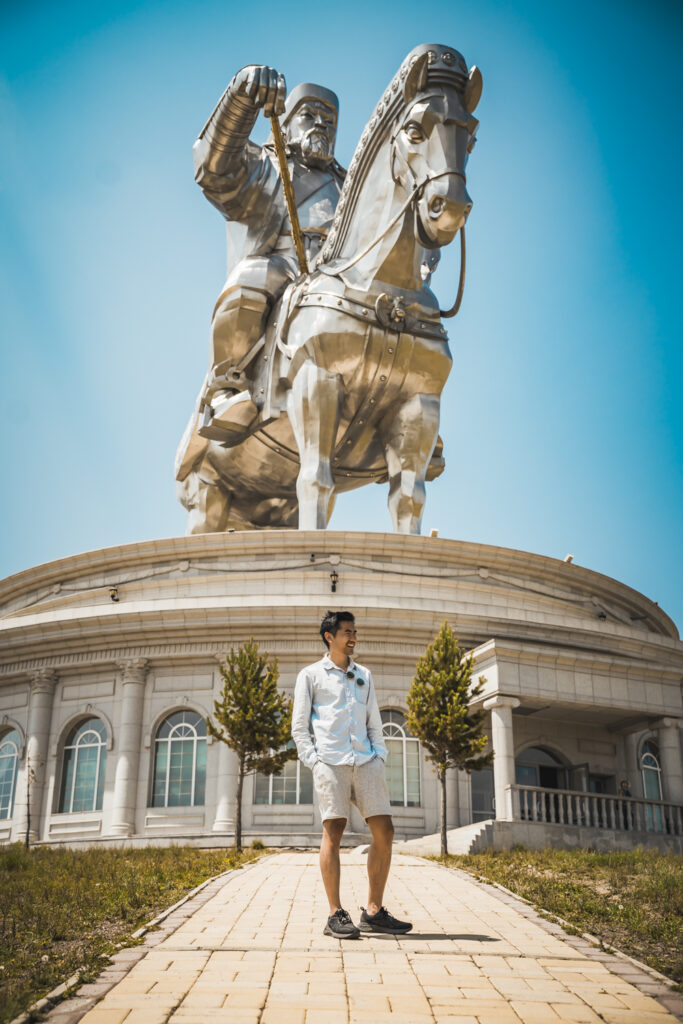
4 – The Sheer Impressiveness of the Mongol Empire. There is good reason for the adoration. Chinggis united the numerous fractious nomadic tribes, forging the Mongol Empire whose heyday was in the 13th and 14th centuries. The Mongols cultivated “nomadic land power” (Dune reference = A+?) and used it to string together successful military campaigns, culminating in history’s largest contiguous empire, which stretched from the Pacific Ocean to Central Europe. It all started with Chinggis, who started with nothing. This was all achieved by people who had no permanent home base. Is there a more impressive or interesting empire in world history? Is there a more interesting man?
5 – Movie Recommendation: The Mongol. I stuck to my travel practice of watching a movie relevant to the country I am in. In Mongolia, I watched “Mongol: The Rise of Genghis Khan” (2007), a “biographical drama film that narrates the story that recounts the early life of Genghis Khan who was a slave before going on to conquer half the world including Russia in 1206”. It is a super fun film that increased excitement for a 9-day Gobi Desert tour I was soon going to go on. Even if you aren’t in Mongolia, I highly recommend it because the story of Genghis Khan is as cool as it gets for a historical leader, and it is rare to see these beautiful landscapes in any Hollywood movie.
6 – The Risk of Overreliance on Distant History as a Source of Nationalism. The relationship present-day Mongolians have with Chinggis Khan and the Mongol Empire reminds me of what I observed with Cambodians and Angkor Wat. Both Angkor Wat and Chinggis serve as an enormous source of pride for the people of both countries. Despite the utter impressiveness of both, there is a risk in overrelying on a distant past as a source of uniting citizens. Namely, it takes away focus from solving present-day problems and improving the future. Although I’m not sure to what extent this is present here, given the past clearly has enormous importance to the pride of Mongolians and there seems to be many issues with how things are run from the locals I speaked to, this risk becomes more front of mind.

7 – Ulaanbaatar (UB) First Impression: Soviet Brutalism. Two things are immediately apparent when you enter Mongolia’s cold capital city (it’s the coldest in the world!) of Ulaanbaatar. First, I was actually impressed with how ugly and uninspiring the cityscape is. It is mostly a mix of crumbling Soviet-style brutalist buildings and plain, simple 5-7 storey rectangular apartments – a product of UB being mainly designed by Soviet architects when they were part of the soviet alliance from 1921 and 1991. The only creative thing about them is what pastel shade to paint it. I suppose it is efficient… it certainly made me appreciate Vancouver’s cityscape. I laughed at one Google reviewer who commented “nice views of an ugly city” after visiting the Zaisan Memorial on Zaisan Hill, a site providing the best views of UB. A brutally simple comment…but effective and one I agree with.
8 – UB Second Impression: Large Korean Influence. Second, I was surprised to see how prevalent Korean restaurants are in Mongolia. I wouldn’t be surprised to hear if there are more Korean restaurants than Mongolian restaurants. I was told this is the case because lots of Mongolians move to Korea for work because of higher salaries and then then move back to Mongolia with knowledge of Korean, including food.
9 – The Famed Nomadic Culture in the Countryside. A trip to Mongolia is incomplete without spending a substantial portion of it in the countryside. You must prioritize this. The countryside is where you can meaningfully observe Mongolia’s famed nomadic culture and natural beauty. It is in Mongolia’s vast, emptiness where to this day, 1/3 of Mongolia’s population (so about 1 million people) continue to live a nomadic herding lifestyle similar to that of those living in the Mongol Empire era, 800 years ago. Of course you have different “countryside” places to visit, with the two main ones being the Gobi Desert in the South and Lake Khuvsgal in the North (where you can see reindeer). Since Canada has many lakes, I opted to see the desert. Because the roads are almost non-existent, it is highly advisable you join a group tour and not try to do it on your own. In the end, my group tour with 3 others cost $75 USD/day.

10 – The Lifestyle Imposed by Mongolia’s Extreme Geography and Climate. The Mongols’ mastery of this nomadic lifestyle was not a strategic decision but something made necessary due to Mongolia’s harsh environmental conditions. While it is the 18th largest country in land area, only 0.4% of the land is arable and suitable for crop cultivation due to it’s geography and climate. Consequently, developing a large scale settled Agricultural Society is impossible, and a nomadic lifestyle, which involved herding and ranching livestock, was not only more suitable but the only viable option. The geography and climate is why Mongolia is one of the emptiest countries in the world, with half of the population concentrated in UB.
11 – Mongolian Geography and Climate: TL/DR Summary. Mongolia is a country that (i) exists across the “high Mongolian plateau”, a region of high elevation across Central Asia that is 1000 metres above sea level, (ii) is contained on all sides by even higher mountain ranges, and (iii) is the biggest landlocked country not bordered by a body of water. As a result, it is the sunniest country in the world (also nicknamed “The Land of the Eternal Blue Sky”), rarely receives precipitation, and is very, very dry. Geography has important implications on the lifestyle and culture of any country but it is especially important to Mongolians.
12 – Mildly amusing: UB is a city with no water drainage system. The fact rain is very rare in Mongolia likely explains why there is no water drainage system in UB. Interestingly, the one week I am in UB there was pouring rain and a dump of snow so I found it mildly annoying hobbling around UB seeing the main sites (I sprained my ankle the day before flying into Mongolia at the Great Wall of China) while trying to avoid huge puddles.

13 – Adventures through the Gobi. – After my #hobblesthroughUB, I finally recovered enough to the point I was confident in signing up for a 9-day tour through the Gobi Desert in Southern Mongolia. This is where my Mongolian adventure truly begun. I spent some time in desert before (e.g., Huacachina, Peru), butnever spent a long period of time in a desert that is this vast. The Gobi is the world’s 6th largest desert (it is larger than Thailand, Spain, and the UK combined) and is classified as a Cold Winter Desert. In total, these 9 days ended up being one of my favourite ever travel experiences.
14 – Lessons from the Gobi: “The beauty is in the nothingness”. The Gobi has five ecological regions, ranging from rolling steppe, to valleys, to sand dunes, to rocky mountains. In our Russian UAZ, my tour group visited the main hot spots across these ecological regions, however it’s important to note that each site was split up by very long, often bumpy drives in the “middle of nowhere”. After describing my Gobi experience to a new and very helpful local friend, Khongoro, as “visiting a beautiful site followed by a whole of boring nothingness”, Khongoro responded with this zinger: “the beauty is in the nothingness.” She added, “don’t you feel free in the middle of nowhere?” As I sat on a camping chair outside my Ger under a starry night later that trip, it dawned on me that an alternative lifestyle like this wouldn’t be so bad if you were with the right people and had the right skills.

15 – The Gobi Experience: Meaningful Observation, not Meaningful Interaction. With respect to “deep travel”, there are home stay opportunities with nomadic families. An older Norwegian man I met decided to spend three days with a local nomadic family. I didn’t get the post-trip review from him, but after visiting nomadic families myself, I am finding it difficult to see how meaningful these interactions can be unless you have a translator. No families in the countryside I met knew English, so the idea of him being at some camp sitting alone in his Ger for 3 days, after paying hundreds of dollars, with nothing to do amuses me. Instead of meaningful interaction, what you do get on an extended trip in the countryside is meaningful observation opportunities. I harked back to what Khongoro said about a feeling of freedom in the countryside – it wasn’t always the case with the teenage boys, but the children and parents I did see came across as stressless and content, possibly since they are not limited by most modern life problems.
16 – Expansion of the Gobi Desert and the Erosion of Nomadic Life. At the same time the Gobi Desert is expanding (specifically at a rate of about 3600 square kilometeres per year), it sounds like there is a decline in traditional nomadic life. Through our cook (and also translator), I learned that many of the nomadic families we interacted had children living in Ulaanbaatar, including their adult children. Could Mongolia’s nomadic culture (one of the world’s last surviving) be threatened?
17 – Mongolian Toughness: “The Not Feeble Asians”. “Us Mongolians, we are not the feeble asian type” declared Khongoro. Toughness is a hallmark of the Mongolians. It’s difficult to describe exactly why they give off that impression, but the fact they tend to be less quick to smile, am told they are quick to fight over anything., are on average physically bigger than most other Asians contribute to this impression. Moreover, in certain other Asian countries when you walk as a foreigner, you get this sense that there is some fascination with you, but that is less obvious in Mongolia. Mongolians have this grittier cool attitude and seem very confident in their own culture.

I discussed with one of my Airbnb hosts at length in Ulaanbaatar about Mongolian culture. He reaffirmed my view that Mongolians are tough and compared them to other Southeast Asians: “in Thailand for example you will see women fawning over Western guys, but Mongolians aren’t like that. They’re tough. They won’t ever put themselves in that position”. I’m confident some of this toughness derives from growing up on Yak cheese, which is incredibly sour.
18 – Chinggis Energy. I coined a term for this Mongolian toughness: “Chinggis Energy”. Chinggis Energy is especially apparent in the babies and children of the Mongolian countryside (the “Mongol desert babies”). Mongol desert babies ooze Chinggis Energy. Tough, spunky, rarely smiling, fearless, with a lot of fire inside them. I love this attitude. One thing Law said that stood out to me was: “fearlessness in children is a sign of good parenting”. A nomadic lifestyle requires a lot of resilience and grit and I’m certain these triats are passed on to their children.
19 – Is the Arrakis Sandworm in Dune inspired by the Mongolian Death Worm? Some think so. The Mongolian death worm is allegedly a legendary creature (similar to Bigfoot or the Loch Ness monster) existing in the Gobi desert. One memorable moment of my trip was playing “Only I Will Remain” by Hans Zimmer (from Dune: Part Two) while on a dune with no one around – a perfect song for that moment.

20 – Two-humped Bactrian Camels. Gobi is home to the two-humped Bactrian camel (aka the Mongolian camel) and I was mesmerized at first sight. Initially, this because of how ugly their faces were, but later through learning about the features that allow them to thrive in cold, dry, sandy environments. Their two humps store fat, which can be converted to water and energy, which give them their ability to endure long periods of travel without water, and when their fat is depleted the humps become floppy and flabby. The deeper we got into hte Gobi, the sadder the humps became.

21 – Confirmed: I am an Asian Chameleon. You can add Mongolia to the list of countries that people think I’m from. In every country on my trip so far, I was assumed to be a native of that country, by the locals of that country. In Mongolia, I was Mongolian, Cambodian in Cambodia, Thai in Thailad, Laotion in Laos, Chinese in Hongkong and China, and Kazakh in Kazakhstan. Anyone who has spent a day with me can attest to this.
22 – Digital Nomadism. Lastly, speaking of a nomadic lifestyle, my unforgettable Mongolia travel experience has reignited a curiosity in a digital nomad lifestyle (i.e., those who can travel freely due to remote work). Once not even considered due to me wanting to prioritize a family life in a city, seeing several American families live this nomadic lifestyle in Asia makes me believe it is possible, in the right circumstances. Sure, this could just be a passing thought since I am in “travel mode”, but I am having the time of my life on this trip and confident that I could travel for at least another 6 months without wanting to come home.
There you have it! 22 Mongolian musings. If any of them particularly stood out to you, feel free to leave a comment. Keep an eye out for a future post, “The Ultimate Guide to the Gobi”, which describes the Gobi tour experience in detail.
Mongolia Image Gallery








